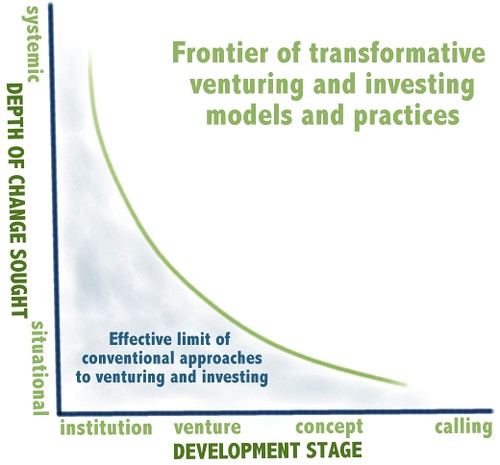Venturing on the frontiers requires distinctly holding attention on two discrete aspects of any venture:
- Productive, iterative, exploration of the complexity dynamic
- Core venture viability
Simple to say but in practice, venturers who aren't stuck in perpetual analysis and thought, are pulled toward focusing on linear, or hopefully exponential, growth of the most promising aspect at hand particularly after attracting professional investment capital. Stop thinking and just do it right?
Well, avoiding the trap of perpetual analysis does not have to mean stop thinking and exploring, it simply means actively cycling through observation, reflection, interpretation, and decision that moves the venture forward. It means not getting stuck. There are many models for doing this with the key aspect being that the focus of the exploration tends toward the deeper purpose, that the cycles are measured in weeks and months as opposed to quarters and years, and that the results change the venture in some way. Explicit attention on this process will ensure that the venture continues to innovate and work toward it's purpose including continually improving upon it's ability to achieve that purpose. Another important consideration in this exploration is that the greater the chasm between the purpose and the daily activity of the organization (as is the case with ventures on the frontiers), the greater the flexibility the venture needs to be able accept and meaningfully enact the outputs of the process. This flexbilty is informative in understanding what is meant by 'core' venture viability.
Core venture viability at its essence is the ability for the venture to maintain its existence in service of its purpose. Commonly, and importantly, a key aspect is financial viability. Early-stage ventures tend to be perpetually resource constrained making the flexibility required of the outputs of the exploration process described above, very difficult. This is where 'core' viability comes in. The core viability does not have to do with maintaining the venture as it is but rather maintaining the ventures ability to continue to serve its purpose which often does not require doing everything that is currently being done. It could be a subset of what is being done, it could be something entirely new. Usually it boils down to concentrated set of people and relationships and the synergistic activity/supports among operations. Taking this perspective can often illuminate the amount of activity that could be done with out. It also will enter into decisions about growing operations and help to clarify what actual purposes of growth related activities are. Another way to look at it might be refined bootstrapping.
The tension created by these two attentions inherently have the potential to compel the venture toward being more efficient and focused with less risk of failure and higher probability of meaningful achievement of its purpose. And like everything else, easier said than done right? Yup.
Blogged with Flock




